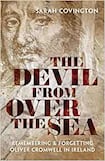
Oliver Cromwell’s first direct involvement with Ireland dates from May 1649 when he was appointed to be lord lieutenant and general of the army designed to defeat all in Ireland opposed to the Commonwealth Government. He arrived in Dublin on August 15th, 1649, and commenced a forceful military campaign in the east and south of the country before his return to England from Youghal on May 26th, 1650.
During this sojourn, Cromwell involved himself with large-scale killings at Drogheda and Wexford where many civilians (particularly Catholic clergy) as well as soldiers were slaughtered in cold blood. Cromwell’s only known previous connection with Ireland was his charitable contribution towards the relief of the Protestant victims of the 1641 rising, and his subscription as an “adventurer” to the fund raised in England in 1642 to enable a revenge attack upon those responsible for that uprising. Once he returned to England in 1650, and until his death in 1658, Cromwell devoted little attention to Ireland and was not directly involved with the confiscation that bears his name.
Sarah Covington’s principal ambition in this intriguing book is to explain why, in every century since the 17th a man who spent but 40 weeks in Ireland, who visited but parts of two of its four provinces, and who was involved only in the military element of the “programme” attributed to him, has loomed so large in Irish memorialisation. She has found, for example, that in the files of the Irish Folklore Commission, assembled principally in the 1930s, Daniel O’Connell is the only historical figure mentioned more frequently than Cromwell.
His notoriety among Catholics was unquestionably related to his representation of himself as an avenging angel at Drogheda and Wexford, but Cromwell was not the first, or the last, Englishman to be involved with, and to justify, massacres in Ireland. Moreover, in the 23 other sieges with which he was involved, Cromwell abided by negotiated surrender terms, even at Clonmel where 2,000 of his own troops had been killed.
READ MORE
Covington’s second major concern is to explain why many Irish Protestants have striven to conceal, but not necessarily forget, the past associations of their families with Cromwell. After these two exercises she interrogates the tension between ascertainable facts and the remembered afterlife of Cromwell, accepting always that what is believed to be true becomes a fact in its own right.
The author provides answers to the questions she has posed in a sequence of thematic chapters dedicated to religion, politics, property, ruins, folklore and migration. Here we learn how Catholic authors, including Gaelic poets, who were aware that particular atrocities had been perpetrated by “henchmen” of Cromwell, still attributed them to Cromwell himself. We learn also how they linked Cromwell personally with every site of their degradation as, for example, the structure built at Inishbofin in 1656 for the incarceration of priests. This soon came to be known as ‘Cromwell’s barracks’ despite its erection six years after Cromwell had left Ireland and its location in the extreme west of a province he had never visited.
Besides considering memorialisation, Covington discusses how and why Protestants in Ireland, who initially saluted Cromwell as a providential deliverer, and absorbed the estates they received following the conquest he had initiated, soon began publicly to deny their associations, or that of their ancestors, with Cromwell, and chose to attribute their good fortune instead to Charles II or William of Orange. She shows how such deception proved futile in Ireland, where the descendants of the dispossessed regularly labelled those who had supplanted them as Cromwellians, in the same way that Protestant publicists reminded Catholics that the killings at Drogheda were justified revenge for the “massacre” of Protestants perpetrated by Catholics in 1641.
Presbyterian hesitancy
Ulster Presbyterians, as Covington explains, refrained from such polemics because Cromwell had been hostile to their ancestors and because they owed their position in Ireland to the earlier Ulster Plantation rather than to the “Cromwellian” confiscation. Besides, to the end of the 18th century, Presbyterians had still not been accorded full civil status in Ireland.
However, the author demonstrates how this Presbyterian hesitancy about embracing Cromwell dissipated in an America immigrant context. There, in an effort to distance themselves from impoverished Catholic emigrants who considered themselves victims of “Cromwellian” landlords, Presbyterians of Ulster descent took to describing themselves as Scots-Irish who had been “planted by Cromwell” in Ireland before their migration to America, where they had proven themselves exemplary citizens by bringing with them the “sober, resolute and God fearing Spirit” of their new-found hero.
As Covington unfolds the solutions to the problems she has posed, she also reveals the variety and wealth of evidence available to those wishing to emulate her in constructing a “landscape of memory”.











